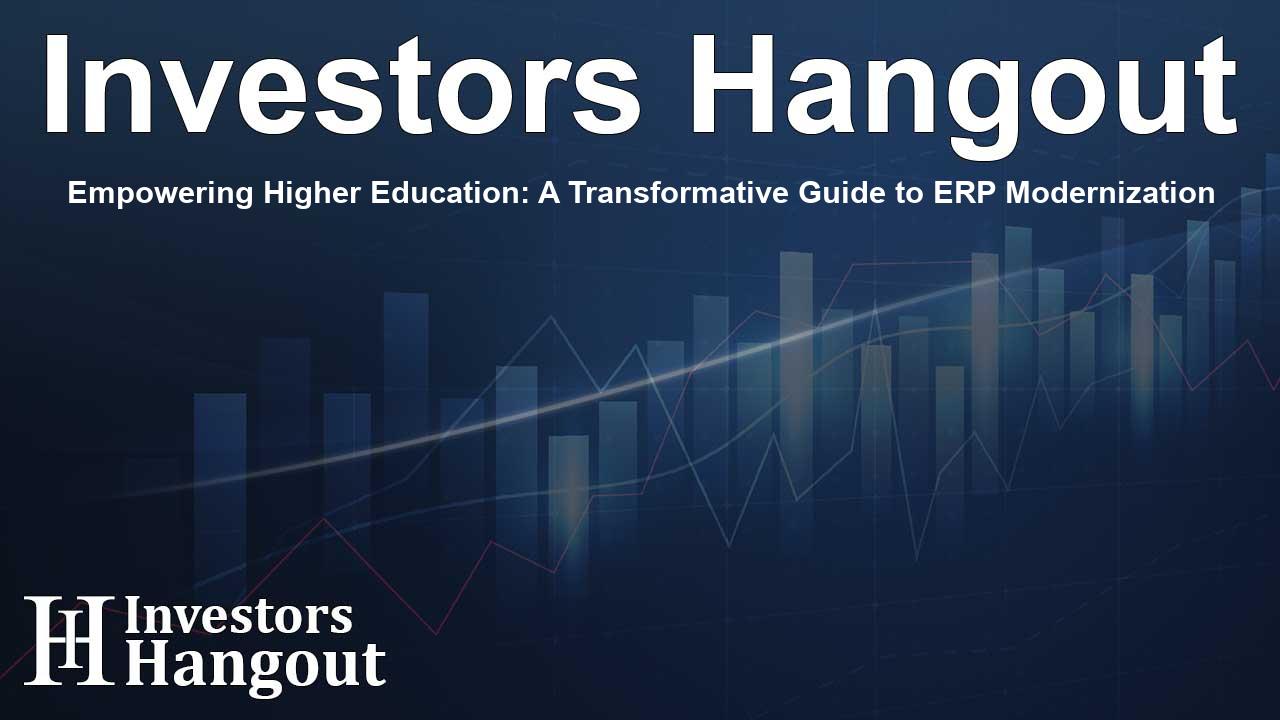Empowering Higher Education: A Transformative Guide to ERP Modernization

Empowering Higher Education Through ERP Modernization
In a rapidly evolving world, Info-Tech Research Group unveils a valuable resource tailored for IT leaders within higher education, designed to modernize enterprise resource planning (ERP) systems. This guide aims to align technological initiatives with the overarching goals of educational institutions, providing foundational insights to overcome issues like data fragmentation and regulatory obstacles, which can hinder progress.
A Timely Opportunity for Upgrades
With recent initiatives aimed at enhancing digital infrastructure, educational institutions are presented with the perfect chance to upgrade outdated systems. However, the task of modernizing legacy systems, including ERP systems, can come with its own set of challenges. These include issues such as fragmented data, stringent regulatory demands, and budget constraints. To assist organizations in navigating these issues, Info-Tech Research Group has introduced a detailed blueprint titled Assess the Strategic Context for ERP Modernization in Higher Education. This resource is designed to offer actionable advice to CIOs and IT leaders, helping them transform their legacy systems and align ERP strategies effectively with their institutional missions.
The Importance of Stakeholder Collaboration
According to Mark Maby, principal research director at Info-Tech Research Group, “Modernizing ERP isn’t just about upgrading technology; it’s a comprehensive strategic transformation that demands robust collaboration with all stakeholders involved.” Maby emphasizes the need for institutions to embrace this shift, as it is vital for enhancing operational efficiency, improving the student experience, and ensuring financial sustainability in the long run. However, challenges such as the complexities of legacy systems and the uncertainty surrounding cloud transitions must be addressed carefully. A well-prepared cost-benefit analysis plays a crucial role in advocating for ERP modernization investments.
Essential Steps for Successful ERP Transformation
The blueprint outlines several critical steps to facilitate successful ERP modernization, guiding institutions through both the strategic planning and implementation stages:
1. Assess the Strategic and Cultural Context
This step involves evaluating the various environmental factors that influence the organization's goals and technological frameworks. Understanding this context is essential for aligning the modernization efforts with both institutional priorities and cultural values.
2. Define Value Streams, Capabilities, and Processes
Institutions must identify their core competencies and key areas of focus, while also considering potential efficiency gains and competitive advantages. A thorough value chain analysis can aid institutions in determining essential requirements from a new ERP system.
3. Evaluate SaaS-Based ERP Vendors
Analyzing the features and functionalities of leading software-as-a-service (SaaS) ERP vendors is critical to choosing a solution that best meets an institution’s unique requirements and strategic objectives.
By effectively aligning institutional priorities and fostering engagement with stakeholders, IT leaders can lay a solid foundation for a successful ERP modernization journey. In times of increased federal support for educational improvement efforts, it is crucial for IT leaders to act swiftly with a clear, strategic vision.
Leveraging Resources for Transformation
Through careful preparation and strategic timing, IT leaders can tap into available resources to facilitate transformation, enhance institutional efficiencies, and strengthen overall academic and operational capabilities. Utilizing the blueprint provided by Info-Tech Research Group, leaders can confidently navigate the complex landscape of ERP modernization.
Frequently Asked Questions
1. What is the purpose of the ERP modernization framework?
The framework aims to assist higher education IT leaders in aligning technology strategies with institutional objectives for improved efficiency and compliance.
2. Who is Mark Maby, and what is his role?
Mark Maby is the principal research director at Info-Tech Research Group, providing insights into the significance of stakeholder collaboration in ERP modernization.
3. What are the main challenges in modernizing legacy systems?
Challenges include data fragmentation, complex regulations, and budget constraints, all of which necessitate careful planning.
4. How can institutions evaluate ERP vendors?
Institutions should analyze the functional capabilities of various SaaS-based ERP providers to find the best fit for their needs.
5. Why is collaboration important for ERP modernization?
Collaboration ensures that modernization efforts are aligned with organizational goals and cultural values, leading to greater success and sustainability.
About The Author
Contact Lucas Young privately here. Or send an email with ATTN: Lucas Young as the subject to contact@investorshangout.com.
About Investors Hangout
Investors Hangout is a leading online stock forum for financial discussion and learning, offering a wide range of free tools and resources. It draws in traders of all levels, who exchange market knowledge, investigate trading tactics, and keep an eye on industry developments in real time. Featuring financial articles, stock message boards, quotes, charts, company profiles, and live news updates. Through cooperative learning and a wealth of informational resources, it helps users from novices creating their first portfolios to experts honing their techniques. Join Investors Hangout today: https://investorshangout.com/
The content of this article is based on factual, publicly available information and does not represent legal, financial, or investment advice. Investors Hangout does not offer financial advice, and the author is not a licensed financial advisor. Consult a qualified advisor before making any financial or investment decisions based on this article. This article should not be considered advice to purchase, sell, or hold any securities or other investments. If any of the material provided here is inaccurate, please contact us for corrections.
